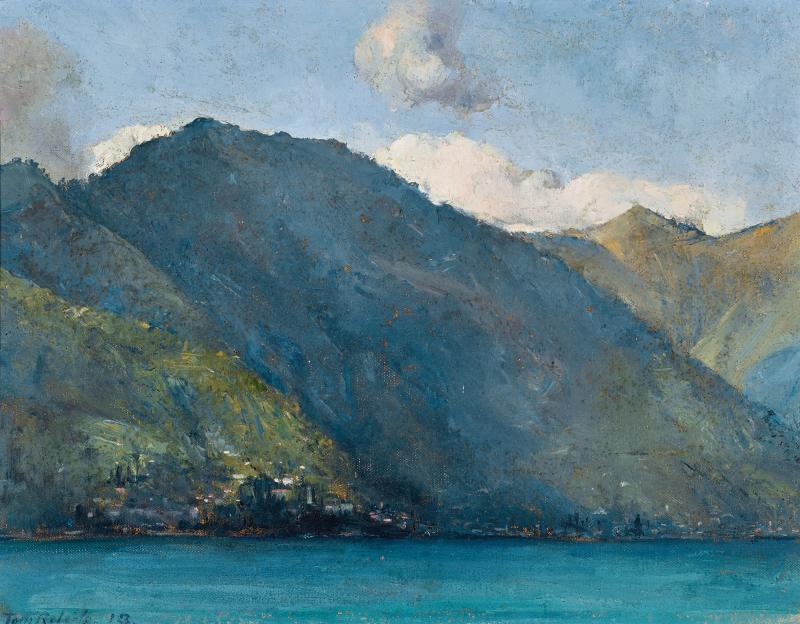TOM ROBERTS (1856-1931)
Lake Como 1913
Estimate: $40000 - 50000
Sold For:
$60000 hammer
$73636 inc. buyer's premium
Description
TOM ROBERTS (1856-1931)
Lake Como 1913
oil on canvas on board
35.0 x 45.0 cm; 53.0 x 61.5 cm (framed)
signed and dated lower left: Tom Roberts 13
bears inscription verso: 20
Provenance:
Private collection, Melbourne, 1920
Private collection, New Zealand
Thence by descent, private collection, New Zealand
Exhibited:
Exhibition of Paintings by Tom Roberts: Principally Lake Como and the Spluga Pass, Walker's Galleries, London, 3-14 February 1914, cat.2 or 3 (as The Heights of Bisbino, Como or Cernobbio)
Reference:
Topliss, H., Tom Roberts, 1856-1931: A Catalogue Raisonné, Oxford University Press, Melbourne, 1985, vol.1, p.186, cat.445
Estimate: $40000 - 50000
Result Hammer: $60000
1913 found Tom Roberts living and working in Northern Italy, painting a series of landscapes which were to be the basis of an exhibition held at Walker’s Galleries in London the following year. He painted the scenery around Lake Como and worked on the surrounding alpine peaks that rise north of Como towards Switzerland. The exhibition was modestly successful and the subject of a Royal visit by Queen Mary.
The present painting shows the western shore of the lake with Monte Bisbino reaching 1314 meters towering over the lakeside town of Cernobbio, a few kilometres north of the city of Como. The Walker’s Galleries catalogue of the exhibition lists several works which can be regarded as candidates for the present work: number 2 The Heights of Bisbino, Como and number 3 Cernobbio. Helen Topliss’ Catalogue Raisonné also records several works which correspond in general way with the present painting, however the New Zealand provenance of number 445, Lake Como, matches the present work.1
After the exhibition Roberts returned to the area but his second visit was cut short by the outbreak of World War I. He returned to London and, at 58 years of age, joined up and spent the following four years serving as a medical orderly.
Born in England, Roberts had initially moved to Australia with his mother, sister and brother following the death of his father in 1868. Working as an assistant to a Melbourne photographer, Roberts studied at the Collingwood Artisans School of Design, and the National Gallery School where he met Frederick McCubbin (1855-1917) and Louis Abrahams (1852-1903). It was in the years following these studies when Roberts was in England and travelling in Spain and France, that he gained first-hand experience of the most recent developments in art. Upon his return to Australia in 1885 he reunited with McCubbin and Abrahams. Together with these men, later joined by Charles Conder (1868-1909) and Arthur Streeton (1867-1943), Roberts formed what became known as The Heidelberg School. He was the driving force behind the momentous 9 x 5 Impressions Exhibition. Years later his role was acknowledged and Roberts became known as ‘the father of Australian landscape painting.’2
By 1913 however, Roberts could be said to have been overtaken by his own success. Shearing the Rams 1888, A Breakaway! 1891 and Bailed Up 1895, had brought him renown and commissions, most notably the heroic feat of painting the now almost completely forgotten The Opening of the First Parliament of the Commonwealth of Australia by His Royal Highness the Duke of Cornwall and York, 9 May 1901.
This commission, requiring three years of effort including taking the likeness of the more than 100 sitters who were present on the occasion, left Roberts exhausted. From then on, he sought subjects suited to his temperament and taste for understatement.3 In the Italian Alps he was also removed from the clamour of new ideas and artistic movements that plagued him in London. Roberts took refuge in Naturalism. The modestly sized and discretely rendered landscapes paintings that predominate his work at this time can therefore be seen as an assertion of independence.
Roberts was at all times inclined to draw on his own resources. The support of his wife, Lillie, found a most apt expression in the finely worked and elaborate frames which she designed and carved, and which are a feature of the present work and others painted at this time.
Footnotes
1. Topliss, H., Tom Roberts 1856-1931: A Catalogue Raisonné, Oxford University Press, Melbourne, 1985, vol.1, p.186, cat.445
2. Croll, R. H., Tom Roberts, Father of Australian Landscape Painting, Robertson & Mullens, Melbourne, 1935
3. Pearce, B., ‘Reflections on the Late Work’, in Radford, R., Tom Roberts, Art Gallery of South Australia, Adelaide, 1996, p.170
Tim Abdallah
Specialists
-

Cameron Menzies, Chairman & Head of Private Sales
cmenzies@menziesartbrands.com
+61 (0) 466 636 142 -

Asta Cameron, Art Specialist
acameron@menziesartbrands.com
+61 (0) 400 914 088 -

Clementine Retallack, Front of House Manager & Associate Art Specialist
cretallack@menziesartbrands.com
+61 (0) 478 493 026
Location
Sale & Exhibition Details
-
Auction
27 March 2024
6:30PM AEDT
1 Darling Street
SOUTH YARRA VIC 3141
artauctions@menziesartbrands.com -
Exhibition
-
Sydney
14-17 March 2024
10:00AM to 5:00PM AEDT
12 Todman Avenue
KENSINGTON NSW 2033
art@menziesartbrands.com -
Melbourne
21-26 March 2024
10:00AM to 5:00PM AEDT
1 Darling Street
SOUTH YARRA VIC 3141
artauctions@menziesartbrands.com
-



